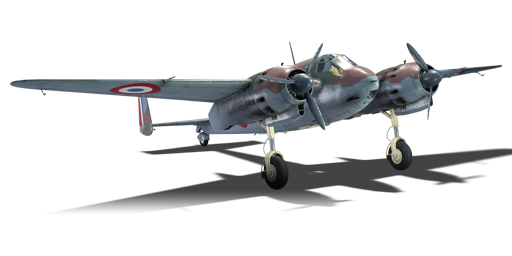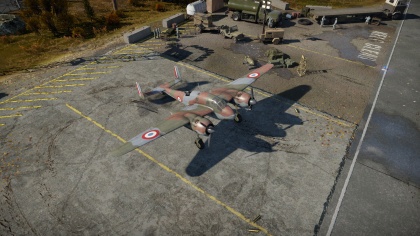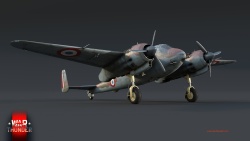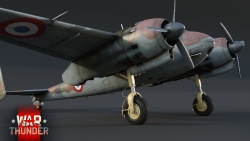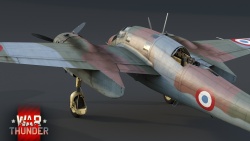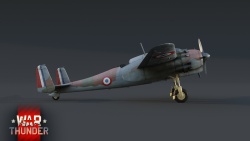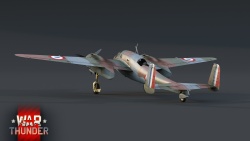Br.693AB2
Contents
Description
The Br.693AB2 is a rank I French attacker
with a battle rating of 2.0 (AB) and 1.7 (RB/SB). It was introduced in Update 1.93 "Shark Attack".
General info
Flight performance
Describe how the aircraft behaves in the air. Speed, manoeuvrability, acceleration and allowable loads - these are the most important characteristics of the vehicle.
| Characteristics | |||||||
|---|---|---|---|---|---|---|---|
| Stock | |||||||
| Max Speed (km/h at 4,000 m) |
Max altitude (meters) |
Turn time (seconds) |
Rate of climb (meters/second) |
Take-off run (meters) | |||
| AB | RB | AB | RB | AB | RB | ||
| 471 | 458 | 9500 | 19.8 | 20.5 | 5.4 | 5.4 | 350 |
| Upgraded | |||||||
| Max Speed (km/h at 4,000 m) |
Max altitude (meters) |
Turn time (seconds) |
Rate of climb (meters/second) |
Take-off run (meters) | |||
| AB | RB | AB | RB | AB | RB | ||
| 523 | 495 | 9500 | 18.8 | 19.0 | 11.0 | 7.8 | 350 |
Details
| Features | ||||
|---|---|---|---|---|
| Combat flaps | Take-off flaps | Landing flaps | Air brakes | Arrestor gear |
| ✓ | ✓ | ✓ | X | X |
| Limits | ||||
|---|---|---|---|---|
| Wing-break speed (km/h) |
Gear limit (km/h) |
Combat flaps (km/h) |
Max Static G | |
| + | - | |||
| 430 | ~9 | ~6 | ||
| Optimal velocities | |||
|---|---|---|---|
| Ailerons (km/h) |
Rudder (km/h) |
Elevators (km/h) |
Radiator (km/h) |
| < 300 | < 300 | < 350 | > 320 |
| Compressor (RB/SB) | ||
|---|---|---|
| Setting 1 | ||
| Optimal altitude | 100% Engine power | WEP Engine power |
| 3,400 m | 670 hp | 804 hp |
Survivability and armour
-10 mm steel seat for pilot
-10 mm steel in front of gunner
-Self-sealing fuel tanks (3 in each wing)
Armaments
Offensive armament
The Br.693AB2 is armed with:
- 1x 20 mm Hispano 404 cannon (90 rpg=90 total)
- 2x 7.5 mm MAC 1934 machine guns (500 rpg= 1000 total)
Suspended armament
The Br.693AB2 can be outfitted with the following ordnance:
- Without load
- 8x50 kg G.A.M.MN bombs
ve armament
The The Br.693AB2 is armed with:
- 2x 7.5 mm MAC 1934T machine guns, dorsal-mounted (500 rpg=1000 total)
- 1x 7.5mm MAC 1934T machine gun, ventral-mounted (1000 rpg=1000 total)
Usage in battles
Describe the tactics of playing in the aircraft, the features of using aircraft in a team and advice on tactics. Refrain from creating a "guide" - do not impose a single point of view, but instead, give the reader food for thought. Examine the most dangerous enemies and give recommendations on fighting them. If necessary, note the specifics of the game in different modes (AB, RB, SB).
Manual Engine Control
| MEC elements | ||||||
|---|---|---|---|---|---|---|
| Mixer | Pitch | Radiator | Supercharger | Turbocharger | ||
| Oil | Water | Type | ||||
| Controllable | Controllable Not auto controlled |
Controllable Not auto controlled |
Controllable Not auto controlled |
Separate | Not controllable 1 gear |
Not controllable |
Pros and cons
Pros:
- Offensive guns are nose mounted
- 20mm cannon is slightly angled to the ground good against light armored ground targets even in horizontal flight
Cons:
- Aiming at air targets is a bit tricky (guns are slightly angled to the ground)
- Belly defensive machine gun is fixed and cannot track enemies
History
Originally designed in response to a 1934 requirement for a three-seat heavy fighter, the Bréguet Bre.690C.3 (C.3 signifying it was a fighter manned by a 3-man crew) was rejected in favour of the Potez 630C.3 as Bréguet had chosen to ignore weight specifications that it found impossible to meet, instead proposing it to the French military as a multi-purpose aircraft. Following this rejection, Bréguet then revised it as a two-seat attack aircraft, with the navigator's position deleted and replaced by a bomb bay capable of holding 460 kg of bombs, and a revised armament of one fixed forward-firing 20 mm cannon supplemented by 2 forward firing 7.5 mm machine guns, one fixed rearward-firing 7.5 mm machine gun in a ventral position, and one flexible 7.5 mm machine gun manned by the rear gunner.
The revised Bre.691AB.2 (AB.2 signifying it was an assault bomber manned by a 2-man crew) first flew in March 1938, leading to a production run of 78 aircraft with Hispano-Suiza 14 engines. Planned production for the Bre.692AB.2 with Gnome-Rhòne 14N engines never went ahead; instead 254 Bre.693AB.2s with Gnome-Rhòne 14M engines were built. Due to a perceived shortage of Gnome-Rhòne engines, Bréguet was also ordered to adapt the design so it could be powered by imported US-built engines: this led to a production run of 50 Bre.695AB.2s powered by Pratt & Whitney R-1830-SB4G Twin Wasp engines. Other projected variants were the Bre.694R.2 reconnaissance version; the Bre.696B.2 bomber version, which had been cancelled in favour of the Bre.693AB.2; and the Bre.697C.2 heavy fighter prototype.
Unfortunately, the Bréguet 690 family saw its career cut short by the Battle of France (May 10 - June 22 1940). France had been late to start the rearmament of its military, originally keeping itself to the strict disarmament treaties of the 1920s, and then finding itself unable to acquire modern military designs due to the economic crisis of the early 1930s. At the time of the German invasion, only 75 of the Bre.691s, 128 of the Bre.693s and 8 of the Bre.695s had been delivered; of these, 119 would go on to be lost during the hectic days of May and June 1940.
While the Bréguet Bre 690 family had been a technically sound design, it was based on an outdated concept: it had been conceived as a low-level, level bomber as the French military did not believe in dive bombers, and thought that tree-top level strafing and bombing of enemy targets gave a better survivability. This was entirely based on the then-current French Army's mobile air defences, which on the one hand consisted of hand-held light calibre machine guns, and on the other hand of World War I vintage slow-firing cannons. By the time the Bre.690 family had started entering service, the French military itself had remedied this defensive gap by the purchase of heavy calibre machine guns and quick-firing cannons; on the German side the Flak 38 had emerged as a potent threat to this flawed tactic, yet despite this no changes were made to the tactical thinking behind the Bréguet Bre.693.
The type saw its first combat on May 12th 1940, when 18 aircraft of the GBA II/54 and I/51 were deployed against German columns advancing through Belgium; the mission quickly revealed the flaws in the level bomber tactic, as the aircraft were easy targets to the quick-firing Flak 38s that were providing cover to the German troops. Out of 18 aircraft, 10 were lost with the loss of 11 crew taken prisoner and 4 crew killed. The disaster prompted the French high command to switch roles of the Bre.690 to that of shallow dive-bomber, a role for which it never had been built: the aircraft lacked a dive-bombing sight and dive brakes, and while the dive-bombing attacks did decrease vulnerability to AA fire, it increased the inaccuracy of its bombing, and made the type more vulnerable to enemy fighters. As a result, 119 of 211 Bréguet 691, 693 and 695s delivered to the French Air Force were lost during the Battle of France with a further 14 too heavily damaged to be repaired.
When defeat became inevitable, the French military started evacuating numerous aircraft to its North African territories in the hope they could continue the fight against Germany from there, but when it came to the Bréguets this proved impossible as they did not have the range to make it across the Mediterranean. The survivors (plus the remainder of the aircraft not yet completed at the time of the French surrender) were pressed into service with the French Vichy Air Force or used as trainers by the Luftwaffe.
Other users of the Bre.690 series were the Italian Regia Aeronautica, which received a small number of Bre.693s as trainers in 1943, and Belgium, which had ordered 32 Bre.694s, and of which the first completed aircraft was undergoing trials in France at the time of the Battle of France. Sweden had placed an order for 12 Bre.694s, to be completed as S10 reconnaissance aircraft, but France fell before any could be built and the order was cancelled as a result.
Media
- Images
See also
Links to the articles on the War Thunder Wiki that you think will be useful for the reader, for example:
- reference to the series of the aircraft;
- links to approximate analogues of other nations and research trees.
External links
| Bréguet Aviation (Société des Ateliers d'Aviation Louis Bréguet) | |
|---|---|
| Attackers | Br.693AB2 |
| France twin-engine fighters and strike aircraft | |
|---|---|
| Twin-engine fighters | Potez 630 · Potez 631 · VB.10C-1 · VB.10-02 |
| Strike aircraft | Br.693AB2 · ▄AD-4 · ▄AD-4NA |
| Netherlands | |
| Twin-engine fighters | ◗Fokker G.IA |
| Strike aircraft | ◘Firefly F.Mk.IV |


